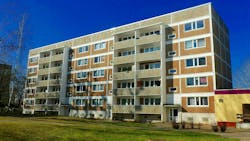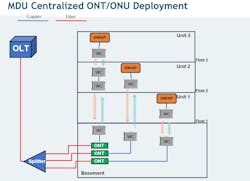Wireless eases the “last 100 feet” problem in multi-dwelling unit (MDU) GPON deployments
By David Sumi / Airvine
Now that the Broadband Equity, Access, and Deployment (BEAD) broadband program is fully funded, a rapid expansion in broadband connections is forecast. GPON will be one of the preferred methods because of its long reach, network architectural flexibility, and capacity to transmit premium-level triple play (voice, video, and data / Internet) services.
However, as we've seen over the years with other broadband technologies, the "last 100 feet" to the end user/customer will remain a thorny problem.
This will be accentuated in the forthcoming BEAD-funded GPON rollouts, as a significant portion is anticipated to connect previously unserved or poorly served MDUs.
A key issue is how a service provider can connect the ONTs deployed at a building (on the rooftop, in the basement, or outside the building at ground level) to all the CPE (such as set-top boxes and Wi-Fi access points) in the residential units and possibly also to the building’s operations network.
Addressing legacy wiring
Connecting optical network terminals (ONTs) to customer premises equipment (CPE) in an existing brownfield MDU presents a problem. These buildings are full of legacy wiring and other obstacles, such as complex layouts that require long cable/fiber runs through walls, ceilings, and conduits. This increases the installation difficulty and cost.
Furthermore, limited space in utility rooms or risers makes installing and managing GPON equipment and cabling even more challenging. Over the years, techniques such as Home Phoneline Network Alliance (HPNA), Multimedia over Coax Alliance (MoCA) and Powerline have been developed to use existing in-building wiring to deliver broadband throughout the premises. However, these techniques have had limited success and were not designed with superfast technology like GPON in mind.
New gig-speed wireless technology that can penetrate thick concrete walls, floors, and ceilings, along with gig-speed interfaces that can accommodate the fiber ports of the ONTs for in-building distribution to residents, will address these problems.
High-speed wireless technology aligns with the BEAD program's goals, offering a rapid and cost-effective solution for GPON deployments in MDUs and multi-tenancy facilities (residential and commercial).
Cost and time benefits
New high-speed wireless systems address other costs and some critical building permitting issues. Eliminating the need for what can be miles of cable (depending on the height of the building, of course) is a great money saver, and adding to that, the much lower labor costs (owing to the faster installation and fewer personnel required) results in a very compelling value proposition.
Other cost-related items pop up when the bill of materials (BOM) for cable installation is too high in buildings with a relatively low number of tenants to share the expenses. Consequently, fewer subscribers could make achieving an adequate ROI more challenging for the ISP. Going wireless “balances the scales” in both situations.
Another area where wireless technology can save much time (and time is, of course, money) is with building construction and renovation permits. First, securing permissions to install new infrastructure in MDUs can be time-consuming and subject to tenant association or property owner regulations. That can be described as an “in-building” problem.
Local zoning and construction authorities are an “outside problem,” and meeting local building codes and regulations adds complexity to the deployment process. This is particularly true regarding the permitting and inspection when it is necessary to drill through walls, floors, and ceilings to run cable. Penetrating these barriers (e.g., concrete walls up to 12” thick) with wireless links makes this a moot point.
And here we might be talking about relatively new buildings. Older buildings (e.g., over 25 years old) have even more difficult legacy wiring issues. They may pose additional constraints related to “historical” or architectural issues or the presence of asbestos in walls and other spaces.
Another top benefit of using this type of wireless technology pertains to what can be called “quality of life” (QoL) issues. First, these wireless backbones and P2P Ethernet bridges can be deployed quickly, enabling faster delivery of broadband services and minimizing disruptions, unsightly wiring and noise for residents.
Later, when it comes time to reconfigure or extend the network, wireless solutions scale seamlessly by adding access points or nodes without physical infrastructure changes, such as additional cabling and splitters and rewiring whole building sections. Such wireless systems have been deployed and proven scalable and easily upgradable, complementing GPON’s capacity and future-proofing the network, which confers a particular “peace of mind” after installation.
The QoL advantages conferred by the wireless approach also pertain to the tasks that come with tenant turnover and ongoing maintenance (less required for a wireless network).
Therefore, a gigabit-speed, concrete-penetrating wireless system surpasses various wireline options in terms of time, convenience, and expense. It addresses multiple critical GPON deployment concerns for property owners and managers, ISPs, MSPs, and other service providers.
David Sumi is the CEO of Airvine. Throughout his 30-plus year career, Sumi has held various roles in various companies, including SVP of Marketing, VP of Engineering, VP of PLM to Director of Systems Engineering.


